Ethnicity, Language and Immigration Thematic Series
Diversity of the Black population in Canada: An overview
Archived Content
Information identified as archived is provided for reference, research or recordkeeping purposes. It is not subject to the Government of Canada Web Standards and has not been altered or updated since it was archived. Please "contact us" to request a format other than those available.
Skip to text
Text begins
Context
The Black population has contributed to Canada’s heritage since the arrival of Mathieu Da Costa (a navigator and interpreter for Pierre Du Gua de Mons and Samuel de Champlain), whose presence in Canada dates back to the early 1600s.
Black people in Canada have diverse backgrounds and experiences – while some can trace their roots in Canada for many generations, others have immigrated in recent decades. They have contributed in many ways to the growth, diversity and development of the country.
In conjunction with both the United Nations’ initiatives for the International Decade for People of African Descent (2015-2024), and Black History Month, this portrait aims to highlight the diversity of the Black population in terms of their ethnic and cultural origins, places of birth and languages.
Start of text box
Population of interest
There are many different ways to define and measure the population of interest: a vastly diverse community of people in terms of history, ethnic and cultural origins, place of birth, religion and languages.
For this portrait, the population refers to persons who self-identified as "Black" in the population group question in the Census of Population. Since the 1996 Census, “Black” is one of the population groups listed on the census questionnaire. Respondents can choose to mark one or more population group, or to specify another group. With the exception of respondents who identified as belonging to both Black and White groups, multiple responses are excluded from this analysis.
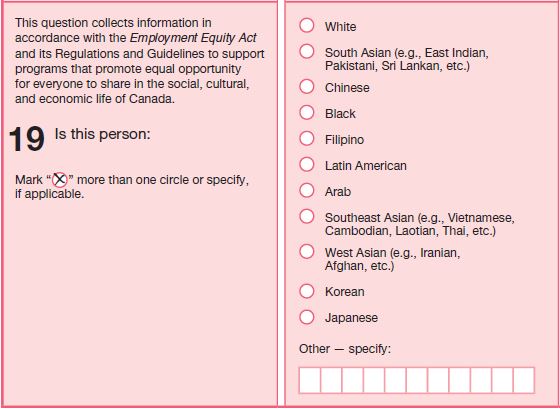
Source: Statistics Canada, 2016 Census of Population 2A-L questionnaire.
Description for questionnaire
The image shows question 19 on population groups from the 2016 Census of Population 2A-L questionnaire. Respondents were asked 'Is this person:' and were instructed to mark one or more of the 11 mark-in categories, or to specify another group in the write-in space, if applicable. The list of mark-in categories are the following:
- White
- South Asian (e.g., East Indian, Pakistani, Sri Lankan, etc.)
- Chinese
- Black
- Filipino
- Latin American
- Arab
- Southeast Asian (e.g., Vietnamese, Cambodian, Laotian, Thai, etc.)
- West Asian (e.g., Iranian, Afghan, etc.)
- Korean
- Japanese
- Other - specify
End of text box
In 2016, close to 1.2 million people in Canada reported being Black
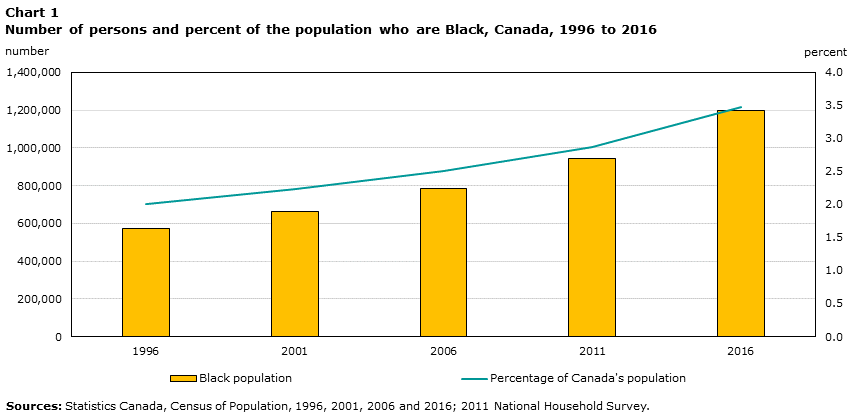
Data table for Chart 1
| 1996 | 2001 | 2006 | 2011 | 2016 | |
|---|---|---|---|---|---|
| number | |||||
| Canada | 28,528,125 | 29,639,030 | 31,241,030 | 32,852,320 | 34,460,060 |
| Black population | 573,860 | 662,215 | 783,800 | 945,665 | 1,198,545 |
| percent | |||||
| Percentage of Canada's population | 2.0 | 2.2 | 2.5 | 2.9 | 3.5 |
| Sources: Statistics Canada, Census of Population, 1996, 2001, 2006 and 2016; 2011 National Household Survey. | |||||
- In 20 years, the Black population has doubled in size, going from 573,860 persons in 1996 to 1,198,540 persons in 2016.
- Among the Black population, 12% have reported being both “White” and “Black” in the 2016 Census.
- The Black population now accounts for 3.5% of Canada’s total population and 15.6% of the population defined as a visible minority.
- According to the population projections from Statistics CanadaNote 1, the Black population would continue to increase and could represent between 5.0% and 5.6% of Canada’s population by 2036.
- Both international net migration (difference between immigration and emigration) and natural increase (difference between births and deaths) have contributed to the growth of the Black population in Canada.
The Black population is a young population…

Data table for Chart 2
| Age group | Black population | Total population | ||
|---|---|---|---|---|
| Male | Female | Male | Female | |
| percent | ||||
| 0 to 4 | 9.5 | 8.6 | 5.7 | 5.3 |
| 5 to 9 | 9.6 | 8.8 | 6.1 | 5.6 |
| 10 to 14 | 8.7 | 8.0 | 5.8 | 5.3 |
| 15 to 19 | 8.8 | 8.0 | 6.1 | 5.6 |
| 20 to 24 | 8.4 | 8.0 | 6.7 | 6.2 |
| 25 to 29 | 7.2 | 7.7 | 6.7 | 6.5 |
| 30 to 34 | 7.3 | 8.0 | 6.7 | 6.7 |
| 35 to 39 | 7.5 | 7.8 | 6.5 | 6.7 |
| 40 to 44 | 7.1 | 7.2 | 6.4 | 6.6 |
| 45 to 49 | 6.5 | 6.6 | 6.7 | 6.8 |
| 50 to 54 | 5.7 | 5.7 | 7.7 | 7.7 |
| 55 to 59 | 4.1 | 4.3 | 7.5 | 7.6 |
| 60 to 64 | 3.0 | 3.2 | 6.5 | 6.7 |
| 65 to 69 | 2.6 | 3.0 | 5.5 | 5.7 |
| 70 to 74 | 1.9 | 2.2 | 3.9 | 4.1 |
| 75 to 79 | 1.1 | 1.4 | 2.6 | 3.0 |
| 80 to 84 | 0.6 | 0.8 | 1.8 | 2.1 |
| 85+ | 0.3 | 0.7 | 1.2 | 1.8 |
| Source: Statistics Canada, Census of Population, 2016. | ||||
- In 2016, the Black population was younger than the total population in Canada. The median age for the Black population was 29.6 years, while it was 40.7 years for the total population.
- Children under 15 years old represented 26.6% of the Black population, while they represented 16.9% of the total population. At the other end of the age spectrum, 7.3% of the Black population were aged 65 years and over, compared to 15.9% of the total population.
- Similar to the total population, there are slightly more Black women than Black men. In 2016, 51.6% of the Black population was comprised of women. This was similar to the proportion in the total Canadian population, where 50.8% of the population was comprised of women.
…with a history in Canada
Canada is the top place of birth of the Black population. In 2016, more than four in 10 Black people were born in Canada.
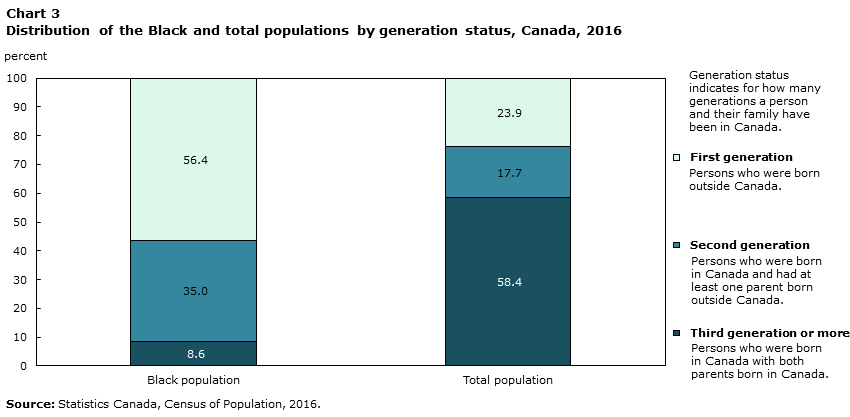
Data table for Chart 3
| Black population | Total population | |
|---|---|---|
| percent | ||
| First generation | 56.4 | 23.9 |
| Second generation | 35.0 | 17.7 |
| Third generation or more | 8.6 | 58.4 |
|
Note: Generation status indicates for how many generations a person and their family have been in Canada. First generation: Persons who were born outside Canada. Second generation: Persons who were born in Canada and had at least one parent born outside Canada. Third generation: Persons who were born in Canada with both parents born in Canada. Source: Statistics Canada, Census of Population, 2016. |
||
About half of the Black population is or has ever been a landed immigrant or permanent resident in Canada…
In 2016, about 623,195 Black people were immigrants, which included landed immigrants/permanent residents and Canadian citizens by naturalizationNote 2.

Data table for Chart 4
| Black population | |
|---|---|
| percent | |
| Immigrant | 52.0 |
| Non-permanent resident | 3.7 |
| Canadian citizen by birth | 44.3 |
| Source: Statistics Canada, Census of Population, 2016. | |
…who came at different points in time

Data table for Chart 5
| Black immigrants | |
|---|---|
| number | |
| Before 1981 | 110,805 |
| 1981 to 1990 | 75,835 |
| 1991 to 2000 | 113,965 |
| 2001 to 2010 | 180,855 |
| 2011 to 2016 | 141,735 |
| Source: Statistics Canada, Census of Population, 2016. | |
…and through different gateways to Canada
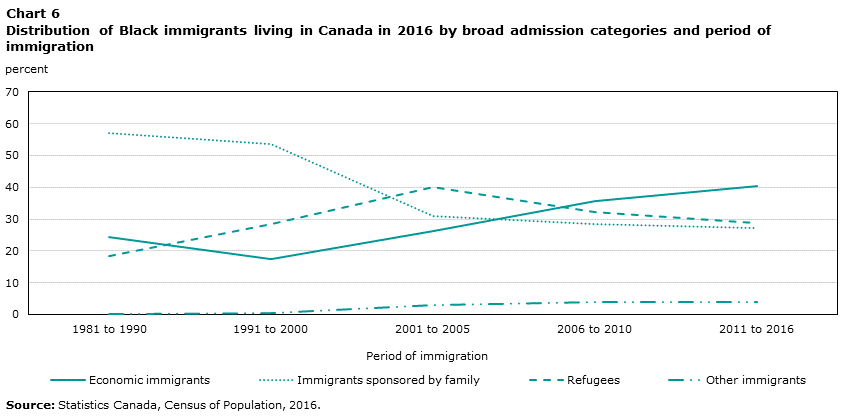
Data table for Chart 6
| Economic immigrants | Immigrants sponsored by family | Refugees | Other immigrants | |
|---|---|---|---|---|
| percent | ||||
| 1981 to 1990 | 24.4 | 57.2 | 18.4 | 0.0 |
| 1991 to 2000 | 17.4 | 53.7 | 28.5 | 0.4 |
| 2001 to 2005 | 26.1 | 31.1 | 40.0 | 2.9 |
| 2006 to 2010 | 35.6 | 28.3 | 32.2 | 4.0 |
| 2011 to 2016 | 40.3 | 27.2 | 28.7 | 3.8 |
| Source: Statistics Canada, Census of Population, 2016. | ||||
- In the late 1960s, Canada’s immigration policy changed significantly. The discriminatory policy based on race or national origins was removed and the first point-based system focusing on criteria such as occupational skills, education and knowledge of official languages was introduced to select economic immigrants.
- Among those who still lived in Canada in 2016, the majority of the Black immigrants who landed in the 1980s and 1990s were sponsored by their family already living in the country.
- Women outnumbered men among those who were admitted in these two decennials. Most of them came from Jamaica and Haiti.
- By contrast, the largest share (40.3%) of Black newcomers (2011 to 2016) were admitted under the economic program. About three in 10 Black newcomers were refugees.
- Top countries of birth of economic newcomers were: Nigeria, Haiti, Cameroon, Côte d’Ivoire and Jamaica.
- Top countries of birth of new refugees were: the Democratic Republic of the Congo, Eritrea, Haiti, Somalia and Ethiopia.
- About 44,285 Black people were non-permanent residents in Canada in 2016. They were living temporarily in Canada on a work or study permit or as refugee claimants (asylum seekers).
The source regions of immigration have changed over time

Data table for Chart 7
| Before 1981 | 1981 to 1990 | 1991 to 2000 | 2001 to 2010 | 2011 to 2016 | |
|---|---|---|---|---|---|
| percent | |||||
| Caribbean and Bermuda | 83.3 | 64.0 | 46.6 | 29.0 | 27.3 |
| Rest of the Americas | 6.7 | 5.4 | 3.9 | 4.6 | 3.5 |
| Europe | 5.1 | 2.4 | 2.0 | 2.8 | 3.4 |
| Africa | 4.8 | 27.7 | 46.8 | 62.7 | 65.1 |
| Asia and Oceania | 0.1 | 0.5 | 0.6 | 0.9 | 0.8 |
| Source: Statistics Canada, Census of Population, 2016. | |||||
Long-established Black immigrants were mostly from the Caribbean, but recent immigrants were predominantly from Africa.
- According to the 2016 Census, more than half (56.7%) of the Black immigrants who landed before 1981 were born in Jamaica and Haiti.
- Black newcomers now come from about 125 different countries. The top countries of birth for Black immigrants admitted between 2011 and 2016 were Haiti, Nigeria, Jamaica, Cameroon and the Democratic Republic of the Congo.
More than 170 different places of birth for the Black immigrants in Canada
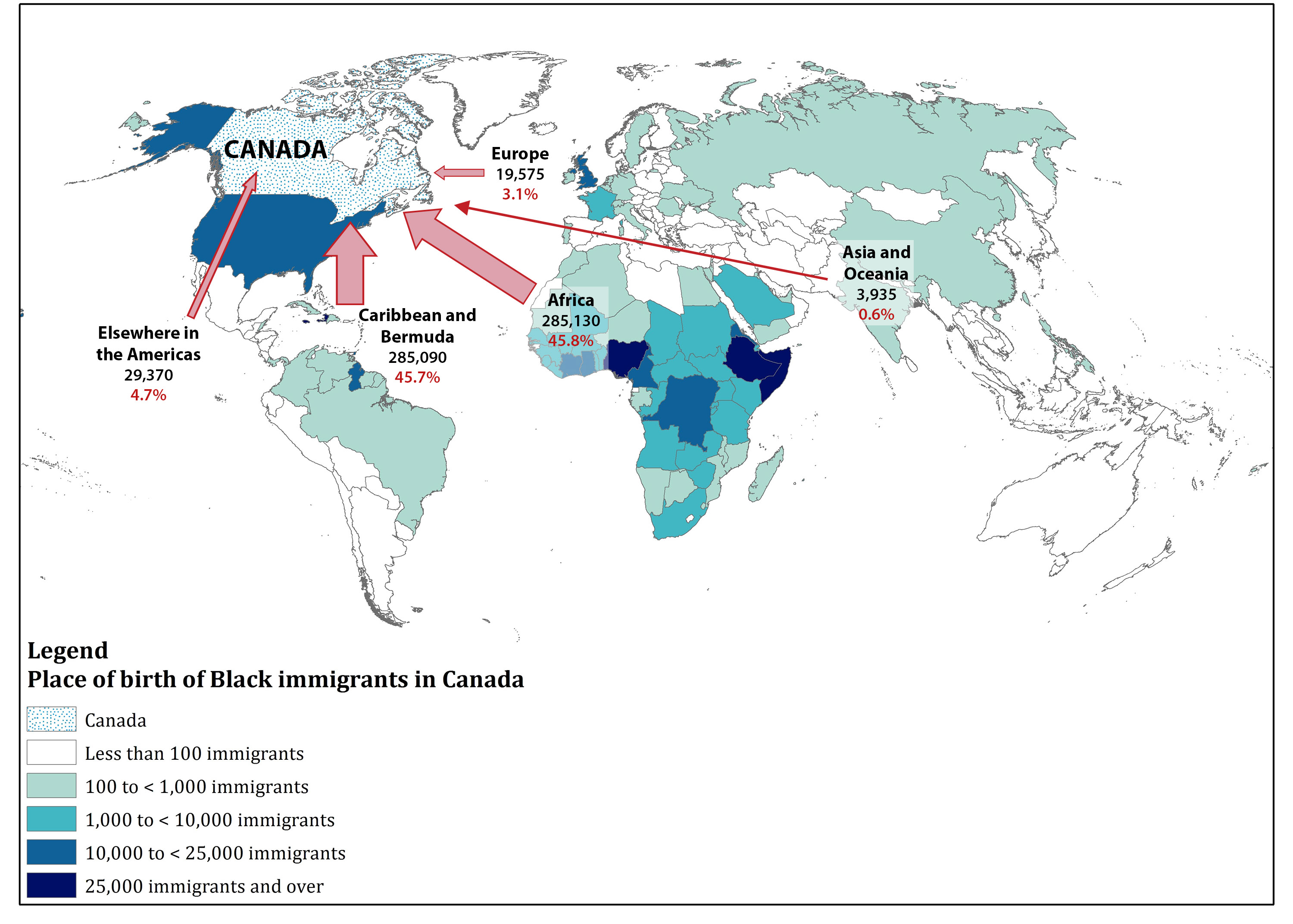
Data table for Map
Map: "Place of birth of Black immigrants, Canada 2016" shows a world map where countries of birth are shaded based on total number of Canada's Black immigrants. The categories include: less than 100 immigrants, between 100 and less than 1,000 immigrants, between 1,000 and less than 10,000 immigrants, between 10,000 and less than 25,000 immigrants and 25,000 immigrants and more.
Geographic regions are mentioned and the number and percentage of Black immigrants who were born in each are noted. An arrow from each region points towards Canada. The size of each arrow denotes the size of the population originating from the corresponding region.
Going from the left side of the world map to the right:
1. Elsewhere in the Americas - 29,370 Black immigrants, or 4.7%
2. Caribbean and Bermuda - 285,090 Black immigrants, or 45.7%
3. Africa - 285,130 Black immigrants, or 45.8%
4. Asia and Oceania - 3,935 Black immigrants, or 0.6%
5. Europe - 19,575 Black immigrants, or 3.1%
| Black immigrants | |
|---|---|
| Total - Place of birth of Black immigrants in Canada | 623,195 |
| Greenland | 0 |
| Saint Pierre and Miquelon | 0 |
| United States | 14,505 |
| Belize | 170 |
| Costa Rica | 45 |
| El Salvador | 10 |
| Guatemala | 10 |
| Honduras | 35 |
| Mexico | 30 |
| Nicaragua | 25 |
| Panama | 100 |
| Anguilla | 45 |
| Antigua and Barbuda | 2,110 |
| Aruba | 210 |
| Bahamas | 995 |
| Barbados | 11,915 |
| Bermuda | 440 |
| Bonaire, Sint Eustatius and Saba | 0 |
| Cayman Islands | 135 |
| Cuba | 790 |
| Curaçao | 150 |
| Dominica | 2,520 |
| Dominican Republic | 665 |
| Grenada | 9,380 |
| Guadeloupe | 365 |
| Haiti | 92,040 |
| Jamaica | 122,550 |
| Martinique | 435 |
| Montserrat | 575 |
| Puerto Rico | 10 |
| Saint Barthélemy | 0 |
| Saint Kitts and Nevis | 1,845 |
| Saint Lucia | 5,435 |
| Saint Martin (French part) | 65 |
| Saint Vincent and the Grenadines | 11,295 |
| Sint Maarten (Dutch part) | 35 |
| Trinidad and Tobago | 20,925 |
| Turks and Caicos Islands | 45 |
| Virgin Islands, British | 40 |
| Virgin Islands, United States | 65 |
| Argentina | 10 |
| Bolivia | 10 |
| Brazil | 395 |
| Chile | 10 |
| Colombia | 320 |
| Ecuador | 30 |
| Falkland Islands (Malvinas) | 0 |
| French Guiana | 135 |
| Guyana | 13,165 |
| Paraguay | 0 |
| Peru | 20 |
| South Georgia and the South Sandwich Islands | 0 |
| Suriname | 150 |
| Uruguay | 10 |
| Venezuela | 190 |
| Austria | 25 |
| Belgium | 690 |
| France | 4,315 |
| Germany | 815 |
| Liechtenstein | 0 |
| Luxembourg | 15 |
| Monaco | 0 |
| Netherlands | 245 |
| Switzerland | 260 |
| Belarus | 10 |
| Bulgaria | 25 |
| Czech Republic | 35 |
| Estonia | 0 |
| Hungary | 20 |
| Latvia | 0 |
| Lithuania | 0 |
| Moldova | 0 |
| Poland | 55 |
| Romania | 100 |
| Russian Federation | 370 |
| Slovakia | 20 |
| Ukraine | 160 |
| Åland Islands | 0 |
| Denmark | 45 |
| Faroe Islands | 0 |
| Finland | 40 |
| Guernsey | 0 |
| Iceland | 0 |
| Ireland | 400 |
| Isle of Man | 0 |
| Jersey | 0 |
| Norway | 85 |
| Sark | 0 |
| Svalbard and Jan Mayen | 0 |
| Sweden | 130 |
| United Kingdom | 10,625 |
| Albania | 0 |
| Andorra | 0 |
| Bosnia and Herzegovina | 15 |
| Croatia | 20 |
| Gibraltar | 0 |
| Greece | 65 |
| Holy See (Vatican City State) | 0 |
| Italy | 650 |
| Kosovo | 10 |
| Macedonia, Republic of | 0 |
| Malta | 30 |
| Montenegro | 0 |
| Portugal | 190 |
| San Marino | 0 |
| Serbia | 35 |
| Slovenia | 10 |
| Spain | 55 |
| Benin | 2,735 |
| Burkina Faso | 1,940 |
| Cabo Verde | 150 |
| Côte d'Ivoire | 10,725 |
| Gambia | 620 |
| Ghana | 22,475 |
| Guinea | 5,055 |
| Guinea-Bissau | 90 |
| Liberia | 2,110 |
| Mali | 2,045 |
| Mauritania | 430 |
| Niger | 975 |
| Nigeria | 41,415 |
| Saint Helena | 10 |
| Senegal | 7,025 |
| Sierra Leone | 2,775 |
| Togo | 3,315 |
| Burundi | 8,145 |
| Comoros | 115 |
| Djibouti | 1,855 |
| Eritrea | 13,950 |
| Ethiopia | 30,960 |
| Kenya | 9,475 |
| Madagascar | 855 |
| Malawi | 335 |
| Mauritius | 1,350 |
| Mayotte | 0 |
| Mozambique | 195 |
| Réunion | 45 |
| Rwanda | 5,755 |
| Seychelles | 525 |
| Somalia | 25,300 |
| South Sudan | 5,175 |
| Tanzania | 2,975 |
| Uganda | 4,155 |
| Zambia | 1,515 |
| Zimbabwe | 6,915 |
| Algeria | 140 |
| Egypt | 920 |
| Libya | 90 |
| Morocco | 255 |
| Sudan | 5,380 |
| Tunisia | 95 |
| Western Sahara | 0 |
| Angola | 1,655 |
| Cameroon | 18,335 |
| Central African Republic | 1,035 |
| Chad | 1,505 |
| Congo, Democratic Republic of the | 24,385 |
| Congo, Republic of the | 2,270 |
| Equatorial Guinea | 50 |
| Gabon | 980 |
| Sao Tome and Principe | 20 |
| Botswana | 630 |
| Lesotho | 80 |
| Namibia | 570 |
| South Africa, Republic of | 2,895 |
| Swaziland | 345 |
| Afghanistan | 10 |
| Armenia | 10 |
| Azerbaijan | 10 |
| Bahrain | 10 |
| Cyprus | 10 |
| Georgia | 0 |
| Iran | 10 |
| Iraq | 20 |
| Israel | 195 |
| Jordan | 15 |
| Kazakhstan | 15 |
| Kuwait | 125 |
| Kyrgyzstan | 0 |
| Lebanon | 70 |
| Oman | 35 |
| Qatar | 80 |
| Saudi Arabia | 1,375 |
| Syria | 95 |
| Tajikistan | 0 |
| Turkey | 65 |
| Turkmenistan | 0 |
| United Arab Emirates | 390 |
| Uzbekistan | 20 |
| West Bank and Gaza Strip (Palestine) | 0 |
| Yemen | 340 |
| China | 190 |
| Hong Kong | 20 |
| Japan | 70 |
| Korea, North | 0 |
| Korea, South | 10 |
| Macao | 0 |
| Mongolia | 0 |
| Taiwan | 0 |
| Brunei Darussalam | 0 |
| Burma (Myanmar) | 0 |
| Cambodia | 0 |
| Indonesia | 0 |
| Laos | 0 |
| Malaysia | 55 |
| Philippines | 155 |
| Singapore | 0 |
| Thailand | 15 |
| Timor-Leste | 0 |
| Viet Nam | 15 |
| Bangladesh | 15 |
| Bhutan | 0 |
| British Indian Ocean Territory | 0 |
| India | 130 |
| Maldives | 0 |
| Nepal | 10 |
| Pakistan | 30 |
| Sri Lanka | 35 |
| American Samoa | 0 |
| Australia | 85 |
| Christmas Island | 0 |
| Cocos (Keeling) Islands | 0 |
| Cook Islands | 0 |
| Fiji | 130 |
| French Polynesia | 0 |
| Guam | 0 |
| Kiribati | 0 |
| Marshall Islands | 0 |
| Micronesia, Federated States of | 0 |
| Nauru | 0 |
| New Caledonia | 0 |
| New Zealand | 20 |
| Niue | 0 |
| Norfolk Island | 0 |
| Northern Mariana Islands | 0 |
| Palau | 0 |
| Papua New Guinea | 30 |
| Pitcairn | 0 |
| Samoa | 0 |
| Solomon Islands | 0 |
| Tokelau | 0 |
| Tonga | 0 |
| Tuvalu | 0 |
| United States Minor Outlying Islands | 0 |
| Vanuatu | 10 |
| Wallis and Futuna | 0 |
| Other places of birth | 95 |
| 0 true zero or a value rounded to zero Source: Statistics Canada, Census of population, 2016 |
|
Jamaica and Haiti are the two main countries of birth for Black immigrants in Canada.
| number | percent | percent of women | |
|---|---|---|---|
| Total | 623,195 | 100.0 | 53.3 |
| Jamaica | 122,550 | 19.7 | 56.9 |
| Haiti | 92,040 | 14.8 | 56.2 |
| Nigeria | 41,415 | 6.6 | 48.4 |
| Ethiopia | 30,960 | 5.0 | 50.8 |
| Somalia | 25,300 | 4.1 | 55.5 |
| Democratic Republic of the Congo | 24,385 | 3.9 | 52.6 |
| Ghana | 22,475 | 3.6 | 49.9 |
| Trinidad and Tobago | 20,925 | 3.4 | 55.6 |
| Cameroon | 18,335 | 2.9 | 50.1 |
| United States | 14,505 | 2.3 | 46.6 |
| Other | 210,305 | 33.7 | 52.0 |
| Source: Statistics Canada, Census of Population, 2016. | |||
Overall, more than 200 ethnic or cultural origins were reported by the Black population in Canada
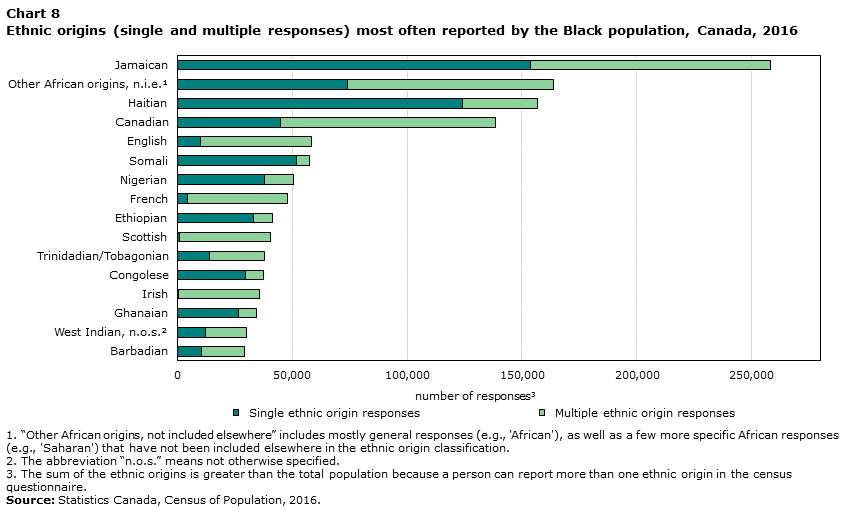
Data table for Chart 8
| Single and multiple ethnic origin responses | Single ethnic origin responses | Multiple ethnic origin responses | |
|---|---|---|---|
| number of responsesData table Note 3 | |||
| Jamaican | 258,350 | 153,840 | 104,505 |
| Other African origins, n.i.e.Data table Note 1 | 163,590 | 74,065 | 89,525 |
| Haitian | 156,915 | 124,195 | 32,720 |
| Canadian | 138,650 | 45,070 | 93,580 |
| English | 58,345 | 10,070 | 48,275 |
| Somali | 57,555 | 51,825 | 5,725 |
| Nigerian | 50,410 | 38,035 | 12,375 |
| French | 47,890 | 4,445 | 43,440 |
| Ethiopian | 41,270 | 33,225 | 8,045 |
| Scottish | 40,615 | 790 | 39,825 |
| Trinidadian/Tobagonian | 38,060 | 13,900 | 24,155 |
| Congolese | 37,590 | 29,460 | 8,130 |
| Irish | 35,840 | 570 | 35,265 |
| Ghanaian | 34,460 | 26,380 | 8,075 |
| West Indian, n.o.s.Data table Note 2 | 30,050 | 12,285 | 17,765 |
| Barbadian | 29,025 | 10,650 | 18,380 |
|
|||
- Ethnic origin refers to the ethnic or cultural origins of the respondent’s ancestors. An ancestor is usually more distant than a grandparent.
- Close to 30% of the Black population reported more than one ethnic origin in 2016.
- The 10 most frequently reported origins among the Black population were: Jamaican, AfricanNote 3, Haitian, Canadian, English, Somali, Nigerian, French, Ethiopian and Scottish.
- In 2016, five new African origins were published in the census products: Edo, Ewe, Malinké, Wolof and Djiboutian – a reflection of the most recent immigration waves.
The long established Black population in Canada is more likely to report several ethnic or cultural origins
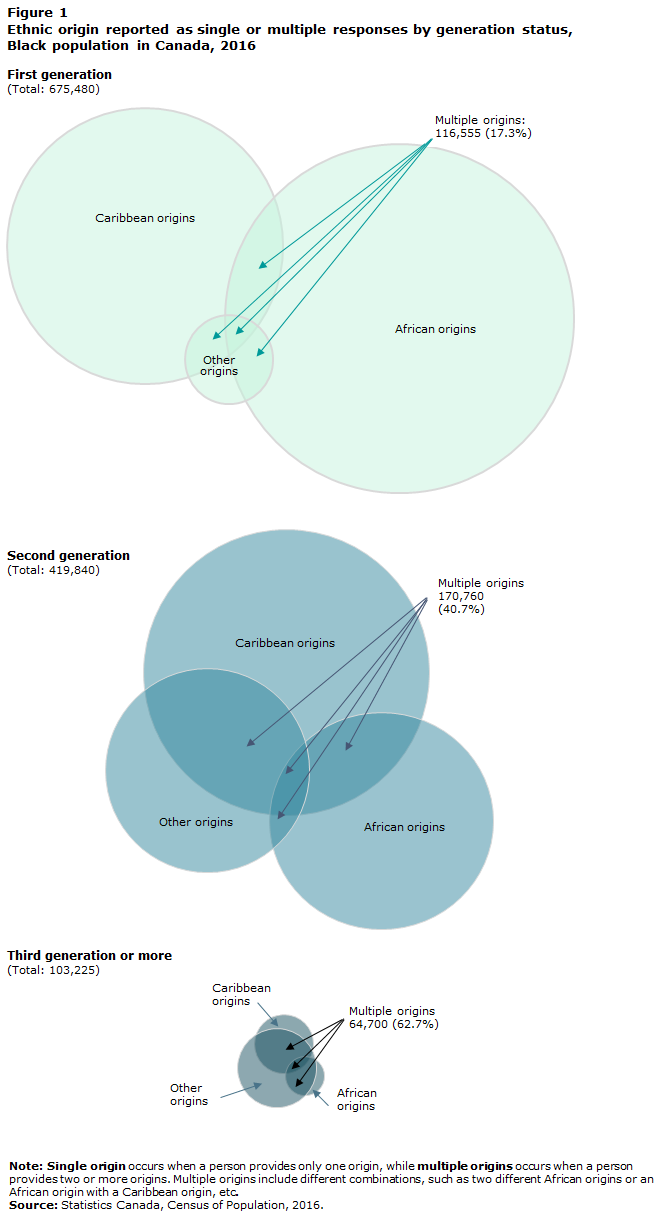
Data table for Figure 1
| First generation | Second generation | Third generation or more | |||||||
|---|---|---|---|---|---|---|---|---|---|
| Total - Single and multiple ethnic origin responses | Single ethnic origin responses | Multiple ethnic origin responses | Total - Single and multiple ethnic origin responses | Single ethnic origin responses | Multiple ethnic origin responses | Total - Single and multiple ethnic origin responses | Single ethnic origin responses | Multiple ethnic origin responses | |
| number | |||||||||
| Black population | 675,480 | 558,925 | 116,555 | 419,840 | 249,080 | 170,760 | 103,225 | 38,520 | 64,700 |
| Caribbean origins | 281,560 | 224,435 | 57,125 | 223,975 | 112,700 | 111,275 | 42,245 | 9,030 | 33,210 |
| African origins | 386,785 | 309,670 | 77,120 | 176,230 | 105,055 | 71,175 | 28,995 | 3,705 | 25,285 |
| Other origins | 96,615 | 24,820 | 71,795 | 166,875 | 31,325 | 135,550 | 87,655 | 25,785 | 61,870 |
|
Percentage of first generation with multiple ethnic origin responses, 17.3% Percentage of second generation with multiple ethnic origin responses, 40.7% Percentage of third generation or more with multiple ethnic origin responses, 62.7% Note: Single origin occurs when a person provides only one origin, while multiple origins occurs when a person provides two or more origins. Multiple origins include different combinations, such as two different African origins or an African origin with a Caribbean origin, etc. Source: Statistics Canada, Census of Population, 2016. |
|||||||||
- In 2016, 62.7% of the third generation or more Black population reported more than one origin, compared with 40.7% and 17.3% of the second and first Black generations, respectively. Various factors can explain why people report more than one origin, such as mixed marriages between people from different ethnic or cultural backgrounds or knowledge of family history.
- African and Caribbean origins are the most common ethnic origins reported by the first and second Black generations in Canada. Jamaican, AfricanNote 3, and Haitian are the three most common origins reported by the foreign-born Black population (first generation in Canada), while Jamaican, Canadian and Haitian were reported by the second generation (born in Canada, with at least one parent born abroad).
- The third generation or more have a longer history in the country. They have reported less often Caribbean and African origins. It includes: Canadian, Jamaican, AfricanNote 3, English, Irish, Scottish, French and First Nations (North American) origins.
The mother tongues reported among the first generation Black population are much more diverse than the mother tongues among the third generation or more
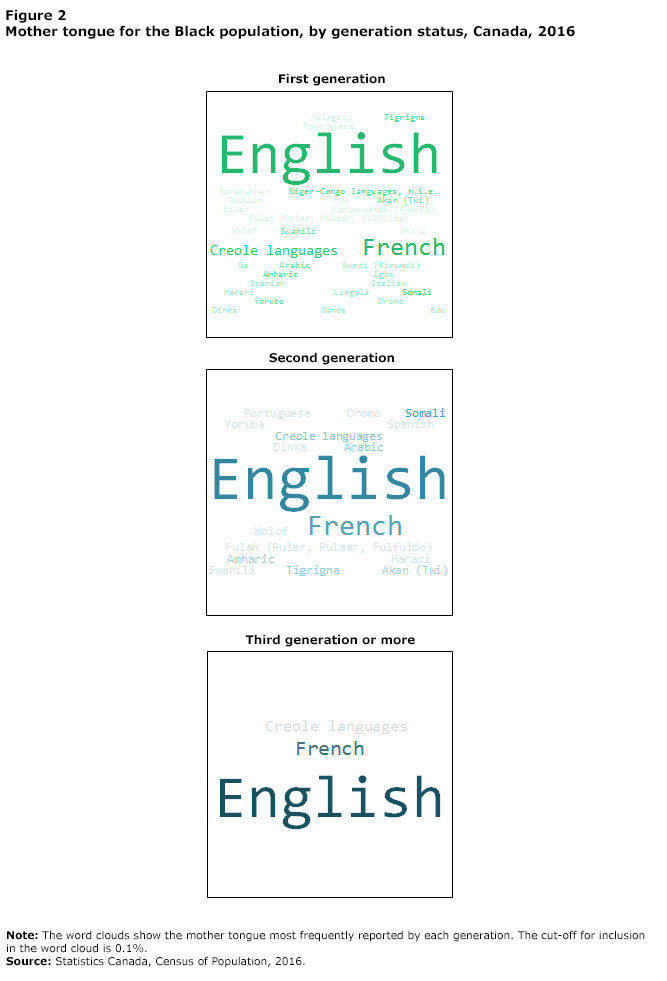
Data table for Figure 2
| Percent | |
|---|---|
| First generation | |
| English | 45.0 |
| French | 14.6 |
| Creole languages | 8.9 |
| Somali | 4.1 |
| Amharic | 2.9 |
| Niger-Congo languages, n.i.e.Data table Note 1 | 2.7 |
| Tigrigna | 2.1 |
| Akan (Twi) | 1.8 |
| Swahili | 1.6 |
| Yoruba | 1.3 |
| Arabic | 1.1 |
| Rundi (Kirundi) | 0.8 |
| Kinyarwanda (Rwanda) | 0.7 |
| Igbo | 0.6 |
| Oromo | 0.6 |
| Lingala | 0.5 |
| Wolof | 0.5 |
| Shona | 0.5 |
| Fulah (Pular, Pulaar, Fulfulde) | 0.4 |
| Portuguese | 0.3 |
| Spanish | 0.3 |
| Ewe | 0.2 |
| Edo | 0.2 |
| Dinka | 0.2 |
| Bamanankan | 0.2 |
| Ganda | 0.2 |
| Ga | 0.1 |
| Harari | 0.1 |
| Bilen | 0.1 |
| Malagasy | 0.1 |
| Italian | 0.1 |
| Russian | 0.1 |
| Second generation | |
| English | 68.5 |
| French | 22.2 |
| Somali | 1.6 |
| Creole languages | 0.8 |
| Amharic | 0.4 |
| Akan (Twi) | 0.4 |
| Tigrigna | 0.3 |
| Arabic | 0.3 |
| Swahili | 0.2 |
| Oromo | 0.2 |
| Portuguese | 0.1 |
| Yoruba | 0.1 |
| Fulah (Pular, Pulaar, Fulfulde) | 0.1 |
| Wolof | 0.1 |
| Dinka | 0.1 |
| Spanish | 0.1 |
| Harari | 0.1 |
| Third generation or more | |
| English | 88.6 |
| French | 9.8 |
| Creole languages | 0.1 |
Source: Statistics Canada, Census of Population, 2016. |
|
- In 2016, when both single and multiple responses were considered, English was the mother tongue (defined as the language first learned at home in childhood and still understood) of 59.8% of the Black population, while French was the mother tongue of 19.6%.
- Creole languages, Somali, Amharic and Niger-Congo languages, n.i.e.Note 4 were the other top mother tongues most frequently reported. Overall, more than 100 languages were reported as a mother tongue by the Black population in the country.
A higher percent of people within the Black population (28.0%) speak French at home compared to the total population (23.3%)
- The Black population is more likely to speak a language other than English or French at home (28.0% - when all categories are taken into consideration) than the total population (21.8%). In many cases, the Black population speaks English or French primarily at home, in addition to other languages on a regular basis.
- Both the Black population and the total population show similar percentages for those who speak English at home – around 74%.
| Black population | Total population | |||
|---|---|---|---|---|
| number | percent | number | percent | |
| English | ||||
| Languages spoken at home | 1,198,540 | 100.0 | 34,460,050 | 100.0 |
| English spoken at home | 887,955 | 74.1 | 25,694,855 | 74.6 |
| Primarily | 753,605 | 62.9 | 22,031,180 | 63.9 |
| Only | 656,370 | 54.8 | 19,650,025 | 57.0 |
| Mostly | 97,235 | 8.1 | 2,381,155 | 6.9 |
| Equally with another language | 65,275 | 5.4 | 1,488,820 | 4.3 |
| Regularly (secondary use) | 69,075 | 5.8 | 2,174,855 | 6.3 |
| No mention of English | 310,585 | 25.9 | 8,765,195 | 25.4 |
| French | ||||
| Languages spoken at home | 1,198,540 | 100.0 | 34,460,050 | 100.0 |
| French spoken at home | 335,350 | 28.0 | 8,028,300 | 23.3 |
| Primarily | 235,315 | 19.6 | 6,842,960 | 19.9 |
| Only | 143,835 | 12.0 | 5,994,055 | 17.4 |
| Mostly | 91,480 | 7.6 | 848,905 | 2.5 |
| Equally with another language | 54,935 | 4.6 | 366,160 | 1.1 |
| Regularly (secondary use) | 45,100 | 3.8 | 819,180 | 2.4 |
| No mention of French | 863,190 | 72.0 | 26,431,750 | 76.7 |
| Other language(s) | ||||
| Languages spoken at home | 1,198,540 | 100.0 | 34,460,050 | 100.0 |
| Other language(s) spoken at home | 335,655 | 28.0 | 7,500,780 | 21.8 |
| Primarily | 113,205 | 9.4 | 3,950,050 | 11.5 |
| Only | 61,635 | 5.1 | 2,280,995 | 6.6 |
| Mostly | 51,570 | 4.3 | 1,669,055 | 4.8 |
| Equally with another language | 79,745 | 6.7 | 1,481,480 | 4.3 |
| Regularly (secondary use) | 142,705 | 11.9 | 2,069,250 | 6.0 |
| No mention of other language | 862,885 | 72.0 | 26,959,270 | 78.2 |
| Source: Statistics Canada, Census of Population, 2016. | ||||
The vast majority of the Black population live in large urban areas
- In 2016, 94.3% of Black people lived in Canada’s census metropolitan areas (CMAs), compared with 71.2% of the country’s total population.
- Toronto, Montréal, Ottawa-Gatineau, Edmonton and Calgary were each home to at least 50,000 people who reported being Black in 2016.
- Toronto has the largest Black population in the country, with 442,015 people or 36.9% of Canada’s Black population. The size of this population has increased in 15 years, but it now represents a smaller share of Canada’s Black population than in 2001 (46.9%).
- CMAs of Ottawa-Gatineau (Quebec part), Lethbridge and Moncton had the fastest growing Black population in the country between 1996 and 2016.
- Black people represented 7.5% of Toronto’s total population, the highest proportion among census metropolitan areas. Montréal and Ottawa-Gatineau had the second and third highest proportions.
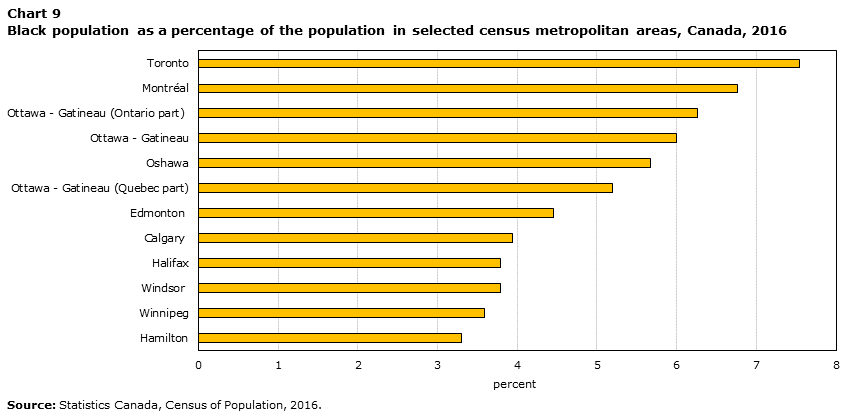
Data table for Chart 9
| Black population in census metropolitan areas | |
|---|---|
| percent | |
| Hamilton | 3.3 |
| Winnipeg | 3.6 |
| Windsor | 3.8 |
| Halifax | 3.8 |
| Calgary | 3.9 |
| Edmonton | 4.5 |
| Ottawa - Gatineau (Quebec part) | 5.2 |
| Oshawa | 5.7 |
| Ottawa - Gatineau | 6.0 |
| Ottawa - Gatineau (Ontario part) | 6.3 |
| Montréal | 6.8 |
| Toronto | 7.5 |
| Source: Statistics Canada, Census of Population, 2016. | |
Atlantic provinces: Longest history
- Nova Scotia has the largest Black population in the Atlantic provinces and the fifth largest Black population in the country.
| Total - Atlantic provinces | Newfoundland and Labrador | Prince Edward Island | Nova Scotia | New Brunswick | |
|---|---|---|---|---|---|
| number | |||||
| Total population in 2016 | 32,080 | 2,350 | 825 | 21,910 | 6,995 |
| percent | |||||
| Population growth rate (1996-2016) | +45.2 | +291.7 | +211.3 | +21.0 | +124.2 |
| Population growth rate (2006-2016) | +27.2 | +159.7 | +27.9 | +14.0 | +57.0 |
| Percent of Canada’s Black population | 2.7 | 0.2 | 0.1 | 1.8 | 0.6 |
| Percent of region/province’s total population | 1.4 | 0.5 | 0.6 | 2.4 | 1.0 |
| number | |||||
| Median age | 26.7 | 22.4 | 22.6 | 28.3 | 25.0 |
| Ratio Men/Women | 98.3 | 104.8 | 107.6 | 96.1 | 102.2 |
| Sources: Statistics Canada, Census of Population, 1996, 2006 and 2016. | |||||

- The majority of the Black population living in Nova Scotia and New Brunswick were born in Canada.
| Total - Atlantic provinces | Newfoundland and Labrador | Prince Edward Island | Nova Scotia | New Brunswick | ||||||
|---|---|---|---|---|---|---|---|---|---|---|
| number | percent | number | percent | number | percent | number | percent | number | percent | |
| First generation | 8,705 | 27.1 | 1,440 | 61.3 | 440 | 53.3 | 3,820 | 17.4 | 3,005 | 43.0 |
| Second generation | 4,550 | 14.2 | 610 | 26.0 | 175 | 21.2 | 2,360 | 10.8 | 1,405 | 20.1 |
| Third generation or more | 18,820 | 58.7 | 300 | 12.8 | 205 | 24.8 | 15,730 | 71.8 | 2,585 | 37.0 |
| Source: Statistics Canada, Census of Population, 2016. | ||||||||||
- Three in four (75.9% or 4,605) Black immigrants in the Atlantic provinces have immigrated between 2001 and 2016.
- Their top birthplaces were Nigeria, Jamaica, and the Democratic Republic of the Congo.
- The ethnic and cultural origins that were the most frequently reported by the Black population in this region included: Canadian, AfricanNote 3, English, Irish, Scottish and French.
- In New Brunswick, close to one third (30.7%) of the Black population had French as their first official language spoken - this was very similar to the overall provincial rate (31.7%).
- Non-official languages that were most reported as a mother tongue included Niger-Congo languages n.i.e.Note 4, Swahili and Amharic.
Quebec: French speaking
- Quebec has the second largest Black population, with 26.6% of Canada’s total Black population.
- In 20 years, the Black population has more than doubled in size in this province – going from 131,970 people in 1996 to 319,230 people in 2016.
| Quebec | |
|---|---|
| number | |
| Total population in 2016 | 319,230 |
| percent | |
| Population growth rate (1996-2016) | +141.9 |
| Population growth rate (2006-2016) | +69.7 |
| Percent of Canada’s Black population | 26.6 |
| Percent of region/province’s total population | 4.0 |
| number | |
| Median age | 29.5 |
| Ratio Men/Women | 93.3 |
| Sources: Statistics Canada, Census of Population, 1996, 2006 and 2016. | |

- The Black population in Quebec is predominately first generation living in the country, but some have also called Canada home for many generations.
| Quebec | ||
|---|---|---|
| number | percent | |
| First generation | 194,010 | 60.8 |
| Second generation | 109,680 | 34.4 |
| Third generation or more | 15,535 | 4.9 |
| Source: Statistics Canada, Census of Population, 2016. | ||
- In Quebec, nearly 43% of the foreign-born Black population were born in Haiti. In fact, the largest Haitian community in Canada live in the census metropolitan area of Montréal.
- About 52,935 (or three in 10) Black immigrants in Quebec are newcomers in the country and were admitted between 2011 and 2016. Close to six in 10 of them came from African countries, but Haiti remains the top source country of recent immigrants.
- About 180 different ethnic and cultural origins were reported by Black people in Quebec, with Haitian as the top reported origin.
- French is the most reported mother tongue by the first (38.5%), second (72.8%) and third generation or more (57.2%) of Black people living in Quebec.
- French is an official language in all of the top six countries of birth of Black immigrants living in Quebec (Haiti, Cameroon, the Democratic Republic of the Congo, Côte D’Ivoire, Senegal and France).
- About 28% reported that they had a mother tongue other than English or French. The top three languages were Creole, Niger-Congo languages n.i.e.Note 4 and Rundi (Kirundi).
- When considering the two official languages of Canada, the Black population with French as their first official language spoken represented 81.1%, while the share of those with English as their first official language spoken was 18.1%.
Ontario: Largest Black population in Canada
- Ontario was home to slightly more than half (52.4%) of the total Black population in Canada.
- Although the overall Black population in Ontario is growing, its share of the Black population in the country has decreased in 15 years. In 2001, 62.1% of Canada’s Black population was living in this province.
| Ontario | |
|---|---|
| number | |
| Total population in 2016 | 627,710 |
| percent | |
| Population growth rate (1996-2016) | +76.2 |
| Population growth rate (2006-2016) | +32.5 |
| Percent of Canada’s Black population | 52.4 |
| Percent of region/province’s total population | 4.7 |
| number | |
| Median age | 30.6 |
| Ratio Men/Women | 89.4 |
| Sources: Statistics Canada, Census of Population, 1996, 2006 and 2016. | |

- Close to half of Ontario’s Black population was born in Canada, which reflects in part, their long immigration history in this province.
| Ontario | ||
|---|---|---|
| number | percent | |
| First generation | 335,025 | 53.4 |
| Second generation | 240,900 | 38.4 |
| Third generation or more | 51,790 | 8.3 |
| Source: Statistics Canada, Census of Population, 2016. | ||
- In Ontario, Black immigrants came from 150 different countries. About one-half were born in the Caribbean, with Jamaica (33.9%) as the leading source country.
- Nigeria, Trinidad and Tobago, Somalia, Ghana and Ethiopia were the five other most frequently reported countries for Black immigrants.
- About 44,415 people in Ontario were Black newcomers (2011 to 2016) and represented 14.1% of all Black immigrants in Ontario. Top countries of birth for this group were Jamaica, Nigeria, Haiti and Ethiopia.
- Overall, more than 200 ethnic and cultural origins were reported by the Black population in Ontario, with Jamaican as the most frequently reported origin.
- Nearly 80% of Black people in Ontario reported English as their mother tongue, and close to 6% reported French.
- Somali, Akan (Twi) and Amharic were the other most frequently reported mother tongues by the Black population in Ontario.
- Among the 83,940 immigrants with French as their first official language spoken in Ontario, 31.4% were Black. This proportion reached 48.4% among newcomers (2011-2016).
The Prairie provinces: Fastest growing
- The fastest growing Black population in Canada is in the Prairies, where it has more than quadrupled in size over 20 years, from 39,955 in 1996 to 174,655 in 2016.
- The Albertan Black population grew fivefold between 1996 and 2016, while Manitoba’s Black population has almost tripled in size and the Black population in Saskatchewan has more than tripled in the same period of time.
- This rapid growth of the Black population in the Prairies has been driven by immigration, mainly from African countries.
| Total - The Prairie provinces | Manitoba | Saskatchewan | Alberta | |
|---|---|---|---|---|
| number | ||||
| Total population in 2016 | 174,655 | 30,340 | 14,925 | 129,390 |
| percent | ||||
| Population growth rate (1996-2016) | +337.1 | +181.6 | +249.9 | +419.3 |
| Population growth rate (2006-2016) | +157.5 | +93.7 | +193.5 | +174.9 |
| Percent of Canada’s Black population | 14.6 | 2.5 | 1.2 | 10.8 |
| Percent of region/province’s total population | 2.8 | 2.4 | 1.4 | 3.3 |
| number | ||||
| Median age | 27.3 | 26.8 | 25.6 | 27.7 |
| Ratio Men/Women | 107.8 | 108.5 | 110.8 | 107.2 |
| Sources: Statistics Canada, Census of Population, 1996, 2006 and 2016. | ||||

- Black people in the Prairies are predominately first generation living in the country, but some have also called Canada home for many generations.
| Total - Prairie provinces | Manitoba | Saskatchewan | Alberta | |||||
|---|---|---|---|---|---|---|---|---|
| number | percent | number | percent | number | percent | number | percent | |
| First generation | 113,395 | 64.9 | 20,515 | 67.6 | 10,290 | 68.9 | 82,590 | 63.8 |
| Second generation | 50,060 | 28.7 | 7,750 | 25.5 | 3,575 | 24.0 | 38,735 | 29.9 |
| Third generation or more | 11,195 | 6.4 | 2,075 | 6.8 | 1,055 | 7.1 | 8,065 | 6.2 |
| Source: Statistics Canada, Census of Population, 2016. | ||||||||
- In 2016, the main birthplaces for Black immigrants in the Prairies were Nigeria, Ethiopia, Jamaica, Somalia and Eritrea.
- About 37,290 of the Black population were newcomers in the country, which represented 36.2% of the Black immigrant population in the Prairies.
- AfricanNote 3, Jamaican and Nigerian were among the top reported ethnic or cultural origins for the Black population in the Prairie provinces.
- Almost all (94.6%) of the Black population in this region reported a single mother tongue.
- English was the mother tongue of more than half of this population, while 4.6% reported French as their mother tongue.
- Those with a non-official mother tongue represented 35.7% of the Black population. Somali, Amharic, and Tigrigna were the top non-official mother tongues reported for the region.
- Of all immigrants with French as their first official language spoken in the Prairies (23,305), 39.8% were Black. This proportion reached 53.3% among newcomers (2011-2016).
British Columbia: Few recent Black immigrants
- In British Columbia the Black population is growing, but at a slower pace compared to neighbouring provinces.
- Between 1996 and 2016, the Black population in British Columbia almost doubled in size.
| British Columbia | |
|---|---|
| number | |
| Total population in 2016 | 43,505 |
| percent | |
| Population growth rate (1996-2016) | +86.9 |
| Population growth rate (2006-2016) | +53.6 |
| Percent of Canada’s Black population | 3.6 |
| Percent of region/province’s total population | 1.0 |
| number | |
| Median age | 28.6 |
| Ratio Men/Women | 106.7 |
| Sources: Statistics Canada, Census of Population, 1996, 2006 and 2016. | |

- Many Black people in British Columbia have a long history in the country.
| British Columbia | ||
|---|---|---|
| number | percent | |
| First generation | 23,465 | 53.9 |
| Second generation | 14,280 | 32.8 |
| Third generation or more | 5,755 | 13.2 |
| Source: Statistics Canada, Census of Population, 2016. | ||
- Black immigrants in British Columbia came from different parts of the world, such as Jamaica, Nigeria, the United States, Ethiopia, Kenya, the United Kingdom and Somalia.
- About 4,405 Black people were newcomers, which represented 2.5% of the total recent immigrant population living the province.
- AfricanNote 3, Canadian, Jamaican, English, American and Scottish were the most frequently reported ethnic origins by the Black population in British Columbia.
- Of the non-official languages reported for mother tongue, the top languages were Somali, Amharic and Niger-Congo languages, n.i.e.Note 4.
- Considering Canada’s two official languages, 94.4% of the Black population had English as their first language spoken compared to 4.4% with French as their first official language spoken. Among Black immigrants, these proportions were 92.0% and 6.0%, respectively.
The Territories: Smallest Black population in Canada
- The Territories had the fewest number of Black people in the country.
| Total - The Territories | Yukon Territory | Northwest Territories |
Nunavut | |
|---|---|---|---|---|
| number | ||||
| Total population in 2016 | 1,350 | 265 | 760 | 325 |
| percent | ||||
| Population growth rate (1996-2016) | +285.7 | +112.0 | +322.2 | +622.2 |
| Population growth rate (2006-2016) | +125.0 | +112.0 | +102.7 | +225.0 |
| Percent of Canada’s Black population | 0.1 | 0.0 | 0.1 | 0.0 |
| Percent of region/province’s total population | 1.2 | 0.8 | 1.8 | 0.9 |
| number | ||||
| Median age | 35.3 | 35.9 | 35.0 | 36.4 |
| Ratio Men/Women | 118.5 | 82.8 | 133.8 | 120.0 |
| Sources: Statistics Canada, Census of Population, 1996, 2006 and 2016. | ||||

- The first generation Black population makes up the majority of the total Black population in the Territories.
| Total - The Territories | Yukon Territory | Northwest Territories | Nunavut | |||||
|---|---|---|---|---|---|---|---|---|
| number | percent | number | percent | number | percent | number | percent | |
| First generation | 865 | 64.1 | 120 | 45.3 | 515 | 67.8 | 230 | 70.8 |
| Second generation | 360 | 26.7 | 95 | 35.8 | 185 | 24.3 | 80 | 24.6 |
| Third generation or more | 125 | 9.3 | 50 | 18.9 | 60 | 7.9 | 15 | 4.6 |
| Source: Statistics Canada, Census of Population, 2016. | ||||||||
- Top places of birth for the Black population in the Territories are: Canada, Jamaica, Zimbabwe, Nigeria, Ethiopia and Somalia.
- Canadian and Jamaican were the two most frequently reported ethnic or cultural origins for the Black population in the Territories.
- The top reported mother tongues: English, French, Niger-Congo languages, n.i.e.Note 4, Arabic and Shona.
Conclusion
This portrait of Canada’s Black population from the Centre for Gender, Diversity and Inclusion Statistics is based mainly on 2016 Census data. It provides a demographic overview of the Black population, as well as key statistics related to their ethnic, cultural and linguistic diversity and a few geographical highlights. However, this portrait is not meant to be exhaustive.
Although it highlights the great diversity within the Black population, it does not present any result related to the several challenges and issues faced by many members of Black communities in Canada.
Challenges and issues such as those related to labour market integration, income inequalities, differential access to resources, health conditions, discrimination, school dropout, etc., may impact differently various groups within the Black population. Moreover, although the Black population generally has similar characteristics compared to the overall population, they often present different socio-economic outcomes. For example, the unemployment rate for the Black population is higher than for Canada’s total population.
Disaggregated 2016 Census data tables with selected demographic, cultural, labour market and income characteristics are available on Statistics Canada’s Census program website which can provide insights on similarities and differences within the Black population as well as between the Black population and other populations in Canada.
New analytical products will be released later which will describe in more detail the characteristics of Canada’s Black population, as well as their socio-economic outcomes.
Acknowledgments
This portrait was prepared by Hélène Maheux and Deniz Do, analysts of the Social and Aboriginal Statistics Division. Special thanks to Jean-Pierre Corbeil and Éric Caron Malenfant for their advice and guidance. The authors also wish to thank Émilie Lavoie, Alejandro Paez Silva, Julien Acaffou, Christine Bizier, Nathalie Villemure and Denis Theriault for their input and assistance in the verification and finalizing of this portrait. They would also like to thank Jennifer Arkell for the creation of the cover page for this portrait.
The authors are also grateful for the members of the Expert Working Group on Black Communities for their invaluable insight and comments for this project. Members include: Malinda S. Smith (professor, University of Alberta), Myrlande Pierre (researcher, Centre de recherche en immigration, ethnicité et citoyenneté de l’UQAM), Carl James (professor, York University), Scot Wortley (professor, University of Toronto), and Frantz Voltaire (director, Centre international de documentation et d’information haïtienne, caribéenne et afro-canadienne).
Notes
- Date modified:

